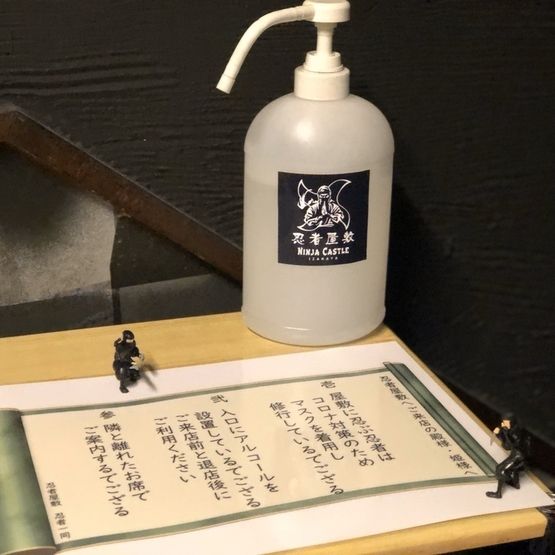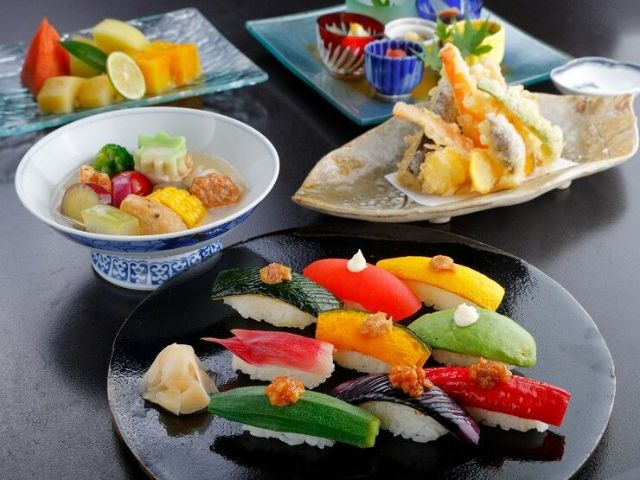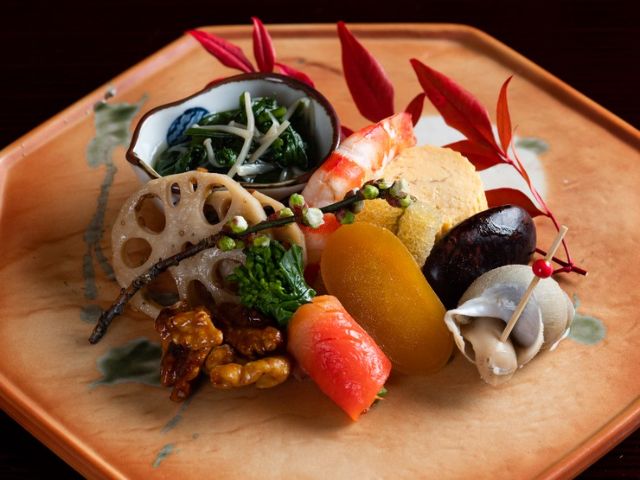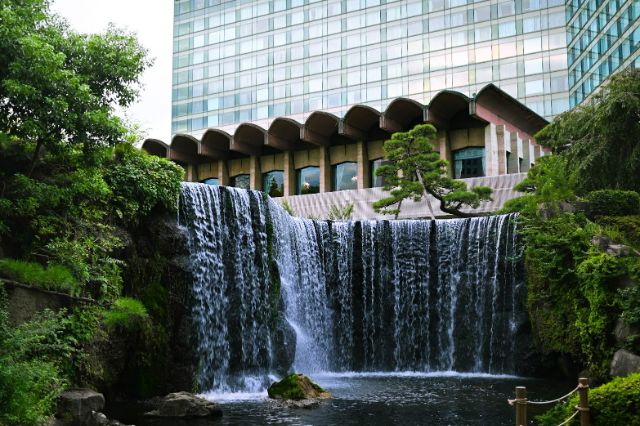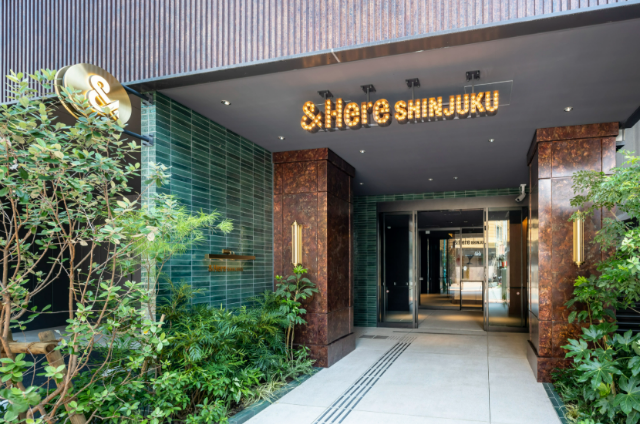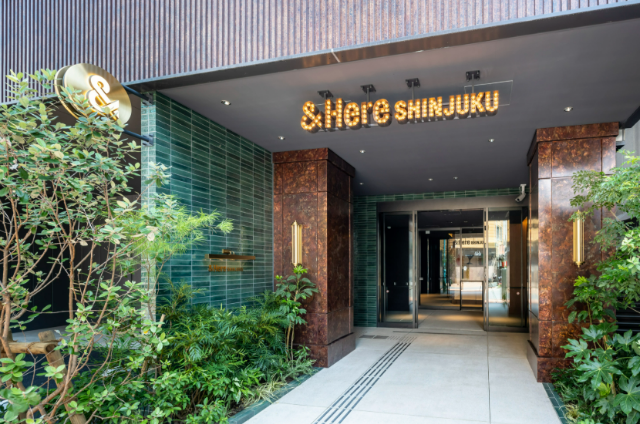Tokyo October: Japanese Dining with Art & Vegan Shojin Ryori Omakase in Omotesando
Update-Date: Nov 27, 2025
Author:
Categories: Kaiseki Shojin Ryori Sake Wine Japanese Cuisine Vegan/Vegetarian/Macrobiotic
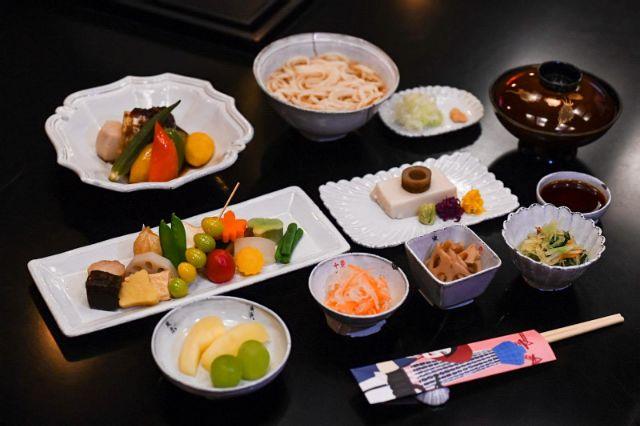

High culture, deep cuisine
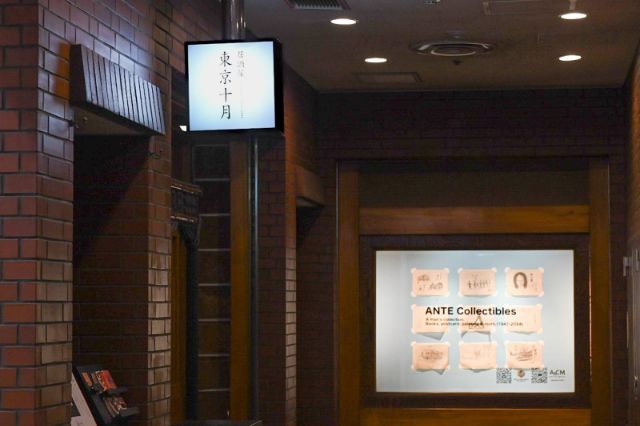
“東京十月” is tucked in a basement corner in the Omotesando-Aoyama neighborhood. On social media, the name is translated as “Tokyo October,” but on official store materials, it’s introduced with the French, “Octubre.”
If you know a little about this restaurant’s story, the French is an obvious fit. The choice goes back to the legacy of artistic visionary and fashion mogul, Takanao Muramatsu, best known for his work at H. P. France. After running the company for over 30 years, he moved on to new projects. These included the establishment and direction of Bar Tokyo October/Tokyo Octubre.

October is the most important month in Tokyo for art and culture events. It’s when fashion and art shows bring creatives from around the world to experience a global exchange of high culture. The restaurant is a space where these creative people gather year round; where it’s always October. Both patrons and artists, those who create and those who are curious, are welcomed to enjoy inspiring Japanese cuisine in a one of a kind venue.
Bar Tokyo October also pours a wide range of alcoholic beverages. These include the refined flavors of regional and luxury nihonshu (sake) and the proprietor’s favorite Argentinian wines. For a small fee, guests are welcome to bring in their own bottles. This policy reinforces the salon concept – bring your own art to share, whether its wisdom or wine.
Tokyo October
Closed: Sunday, National Holidays
Average price: [Dinner] 8,000 JPY
Access: 4-minute walk from Tokyo Metro Omotesando Station, Exit B1. It's on the B1 floor of the Ohararyu Kaikan Building on Kotto-dori.
Address: B1F, Ohararyu Kaikan, 5-7-17, Minami-Aoyama, Minato-ku, Tokyo Map
More Details Reservation
Dining in an Art Gallery
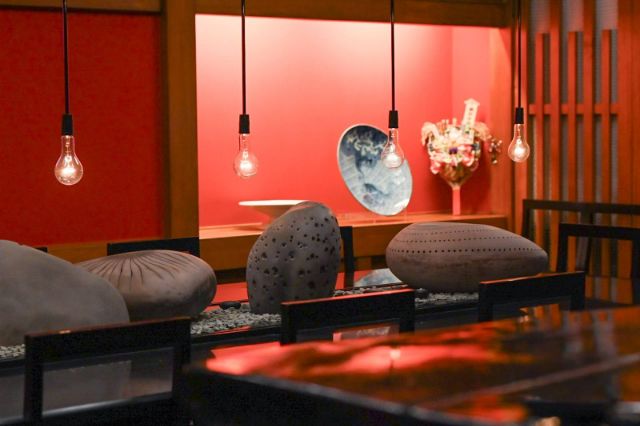
The dining room, which pairs old wood from Kyoto and washi accents with contemporary art and furniture, is as if French design had found its home in the walls of a temple. Traditional tatami rooms decorated with ikebana contrast the contemporary main room, where, upon entry, visitors are enveloped in the amniotic warmth of mahogany red walls and jet black tables. It’s like stepping right into the most opulent Japanese lacquerware.
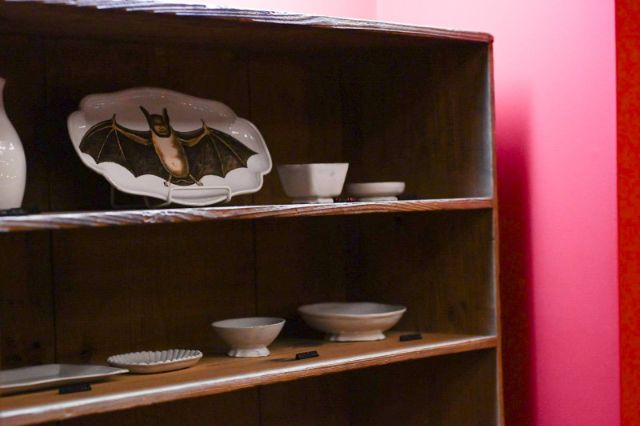
Art, in its many forms, is especially important to the house culture of Bar Tokyo October. Capitalizing on proprietor Muramatsu’s far-reaching connections, the plates and bowls are specially provided by artisan house Astier de Villatte, of Paris. Bar Tokyo October’s ceramics were just for the restaurant, including a sake tokkuri served with the store’s signature banshaku (evening tipple) set, only available here.

The wooden sculpture in the corner is also by a French artist. This striking figure was chosen for its similarity to Buddhist imagery, a nod to the restaurant’s interior design, and for its thought-provoking form.
In a glowing- alcove on the far wall, an impressive sound system is flanked by speakers selected for their excellent Jazz sound quality. Its gold backlight draws the eye towards the impressive tabletop karesansui piece, a rock-garden-like art installation that sits temporarily in place of a water feature.

Originally, the only soundscape was that of flowing water, complementing the natural flow of conversation. As a way to tie more into one harmonious space, a monthly-changing selection of jazz tunes was added and the karesansui was installed. Now, guests enjoy the balance of visual beauty, music, and conversation, just like in Paris’ salons.
One of the important aspects of the space is to exist as a place where people can come to “calm their noisy minds.” The lighting, water, and soundscape all work together to make that possible. Tokyo October’s course-meal only menu does guests a favor by giving them one less decision to make in their day. Diners only need to select their course preference (gluten free, shojin ryouri (vegan), or one of several levels of kaiseki) and sit back to enjoy as plate after delicate plate arrives.
Chef
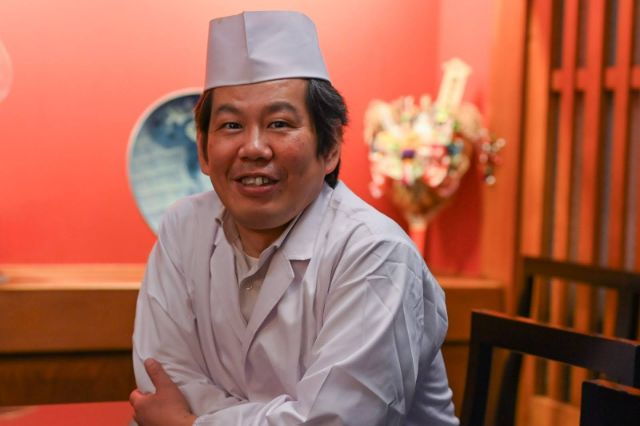
Chef Fuyuno is nonchalant and disarming, for someone cooking with his pedigree. When he talks about food, his eyes light up. He explains that today’s understanding of kaiseki is rooted in chakaiseki meals served before a tea ceremony. Actually only a fairly recent style, kaiseki was likely created within the last two hundred years. He says its origins go even further back, to the formal courses served to daimyo lords and temple rituals.
On top of pursuing classical Japanese cuisine, Chef Fuyuno studied sado, the art of tea ceremony, for 25 years. He was even one of a few masters to be invited to host official tea ceremonies at the Tokyo 2020 Olympics. However, his intense study is not because of a distinct passion in the way of tea, but to become a better chef by understanding the base of Japanese gastronomy. Just as in Bar Tokyo October and the old way of samurai, a balance between emotional art and thoughtful precision come together in his practice. Although Chef Fuyuno doesn’t boast about his skills, his ability to select ingredients and combine them into something exciting, even while working under restraints, is impressive.
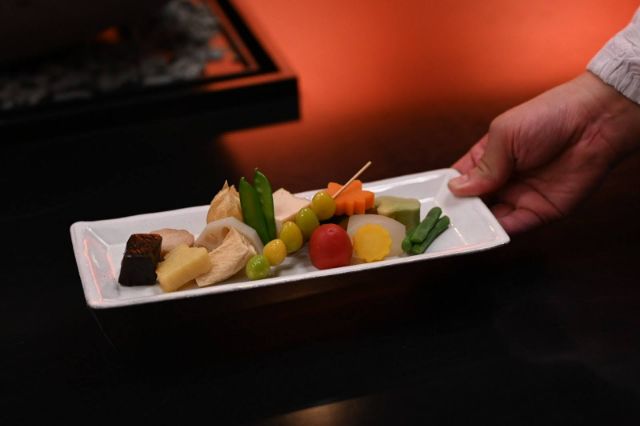
He comments that one of the most interesting things about Tokyo October isn’t that they offer a vegan menu, but that it doesn’t specialize in vegan food. His years of experience studying the fine points of various Japanese cooking techniques allows him to create satisfying vegan menu items for one guest while providing a standard kaiseki array for the next. Although the number of stores that handle vegan and gluten-free diet needs are increasing, he mentions that they tend to specialize, making it less comfortable for groups with many philosophies to dine together.
The Food
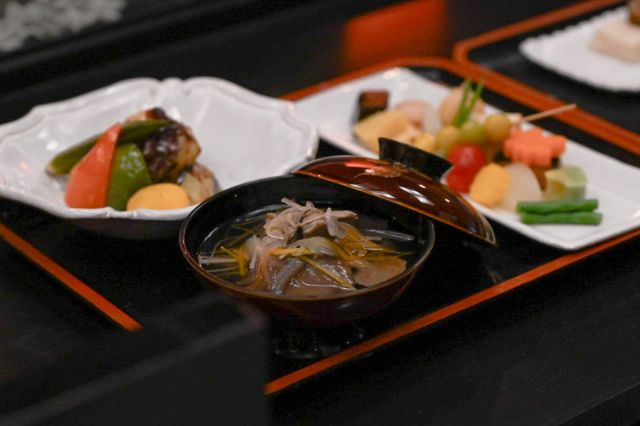
Chef Fuyuno is perfectly happy to adjust his menu options for international guests and offers vegan (shojin ryouri) and gluten free courses as standard. The vegan course pulls dishes from a repertoire of Buddhist temple cuisine, but with the influence of globally-minded Muramatsu-san, it’s only natural that the menu strikes a balance between Japanese tradition and contemporary needs.
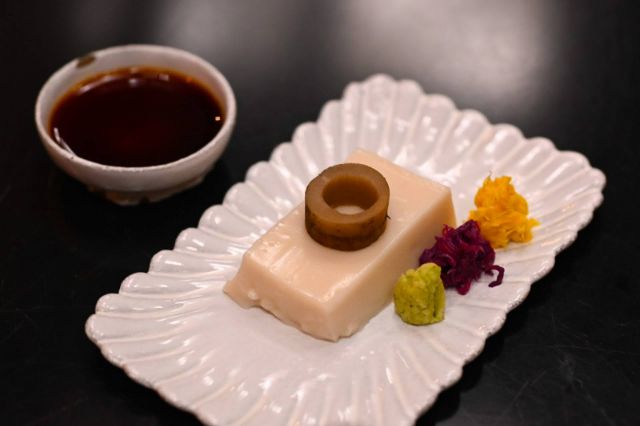
Many of the vegetables featured in Tokyo October’s shojin ryouri vegan course are heirloom varieties grown right in Tokyo. Nemuro gobo (burdock), Shinagawa kabu (turnip), and Senju daikon radish have been cultivated locally since the Edo era (1603-1868), earning the indication, “Edo-yasai.” Even outside of these local heirloom vegetables, Chef Fuyuno sources almost all the produce on the menu from within Tokyo’s boundaries, and even the few that aren’t mostly come from within Kanto. He prioritizes organic farms and holds a deep respect for the origins of each dish.
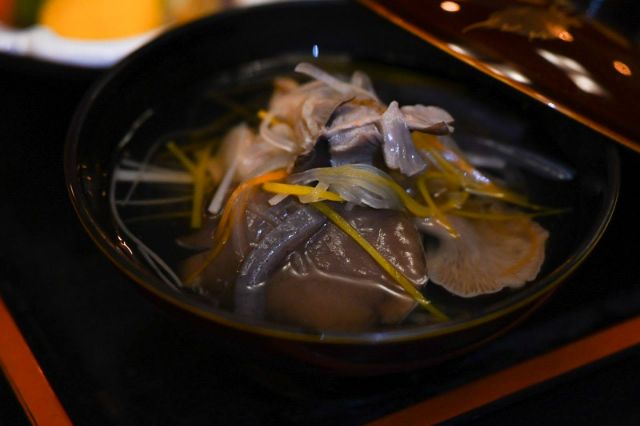
In particular, the owan stands out for its clever technique. Before even taking a sip, a sweet aroma, like candied nuts or fruits, wafts up from the bowl. It’s entirely thanks to complex sugars locked in the root vegetables and mushrooms that have simmered in otherwise simple kombu broth. There’s no salt added, Chef Fuyuno assures us just before cracking dried sansho over the floating islands of mushroom and burdock, “There’s no salt because that would overpower it. It would just be salty. But you still need a kick, so I top it with sansho.” The sansho adds a floral citrusyness that allows the vegetables’ flavor to bloom. This delicate method feels especially attuned to the art of Shojin ryori, which, in addition to being vegan, also doesn’t allow for intense flavorings.
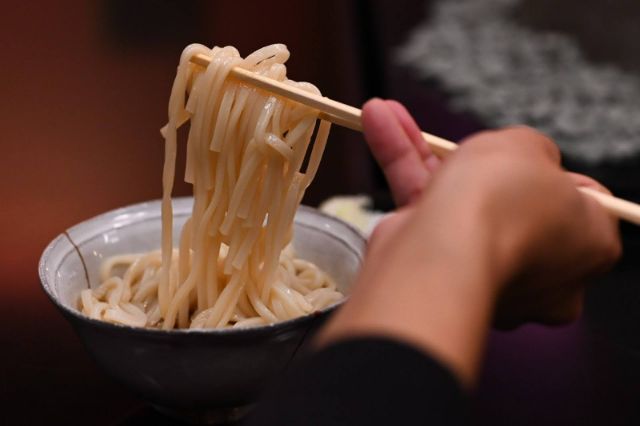

Not every element is restrained, however. The namasu packs a powerful punch of vinegar that makes the daikon even more refreshing. The main dish, featuring an intense soy sauce saute applied to creamy-tender eggplants, will kick some international guests back to the nostalgia of bottled teriyaki sauce. It’s a flavor that’s immediately recognizable as Japanese, despite having been commercialized for daily use overseas. Like the French infatuation with Ukiyo-e and subsequent Japonisme movement, this dish expresses how people across the globe adapt and accept nuances into their own palate.
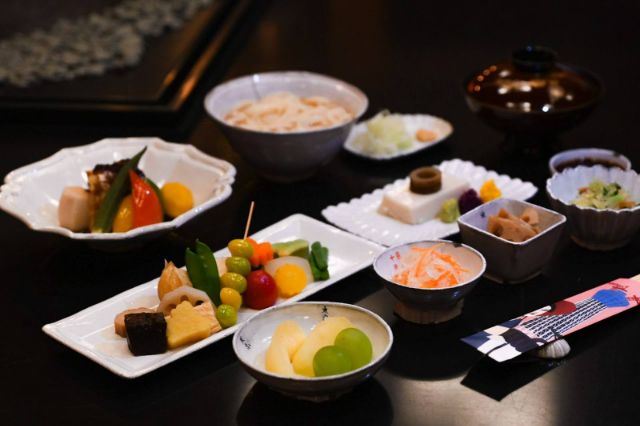
In the past, at the salons of an older Paris, bringing together groups of people with different philosophies, education, and life styles was the most essential element. While it takes elements from the past and filters them through decades of multidisciplinary experience, Bar Tokyo October is a restaurant that exists perfectly in the current moment. Its philosophy makes the restaurant a place where creatives and lovers of the arts and food can exchange passions and ideas. Within this bar and restaurant, the people involved create a new experience that you can’t help but want to be a regular part of. As Bar Tokyo October moves towards the future, it looks to deepen its connection to the role of the salon, starting with food and extending to art and culture.
Summary and Future
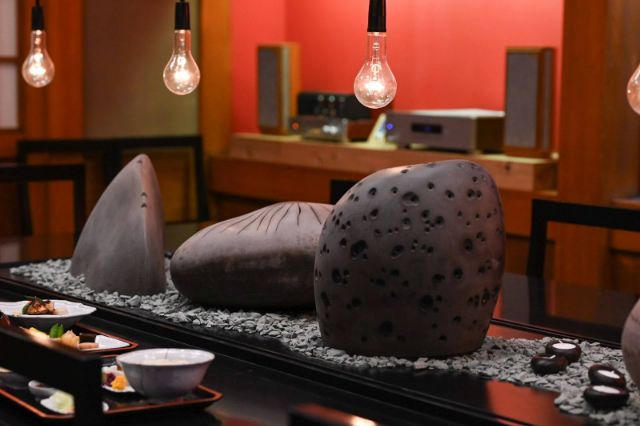
Since the 80’s, Mr. Muramatsu, the benefactor behind Tokyo October’s unique placing, has been integral to the development of contemporary design culture in Tokyo. His passion for global culture extends to music, fashion, and fine art. At Bar Tokyo October, his vision is married to traditional Japanese cuisine. It’s the picture of a modern salon, combining culture, tradition and people, in a venue that couldn’t exist anywhere but Omotesando.
In the next year, the group plans to incorporate even more in the space, displaying pieces from a collection of Taisho-era art across the walls. This body of work, including examples of Japonisme, the rise of Western culture in Japanese graphic art, and more, has been featured in Tokyo’s well respected art museums and will find a new home here, where European aesthetics and Japanese cuisine mingle.
This is truly a one of a kind space where diners can enjoy the intersection of many pieces of art and culture over a traditional meal. Today, and tomorrow, Tokyo October promises to be a valuable part of Tokyo’s artistic and gourmet community. While visiting Tokyo, wander off the straight and narrow and visit this “salon” for an unforgettable experience that goes beyond just delicious.
Tokyo October
Closed: Sunday, National Holidays
Average price: [Dinner] 8,000 JPY
Access: 4-minute walk from Tokyo Metro Omotesando Station, Exit B1. It's on the B1 floor of the Ohararyu Kaikan Building on Kotto-dori.
Address: B1F, Ohararyu Kaikan, 5-7-17, Minami-Aoyama, Minato-ku, Tokyo Map
More Details Reservation
Disclaimer: All information is accurate at time of publication.
Thank you for reading our article.
Our goal is to take your culinary journey to the next level by helping you find the best restaurant. With SAVOR JAPAN, you can search and make reservations for
the Kaiseki, Shojin Ryori, Sake, Wine, Japanese Cuisine and Vegan/Vegetarian/Macrobiotic restaurants found in and around Shibuya and Omotesando, Harajuku, Aoyama that fill your needs.
Discover more Kaiseki, Shojin Ryori, Sake, Wine, Japanese Cuisine and Vegan/Vegetarian/Macrobiotic restaurants by area
- Tokyo Area
- Near Tokyo
- Kyoto and Osaka Area
- Hokkaido Area
- Northern Honshu (Tohoku)
- Central Honshu (Chubu)
- Western Honshu (Chugoku)
- Shikoku
- Kyushu
- Okinawa and Ryukyu Islands
Discover more restaurants to eat Japanese Cuisine, Japanese Cuisine, Alcohol, Alcohol, Japanese Cuisine and Other by area
Update-Date: Nov 27, 2025
Author:
Categories: Kaiseki Shojin Ryori Sake Wine Japanese Cuisine Vegan/Vegetarian/Macrobiotic
Related Articles
New Articles
Categories
Cuisine
- Bars (23)
-
Japanese Cuisine (669)
- Kaiseki (45)
- Nabe (19)
- Okonomiyaki (22)
- Shabu Shabu (36)
- Soba (17)
- Sushi (135)
- Tempura (18)
- Teppanyaki (46)
- Shojin Ryori (3)
- Tonkatsu (10)
- Kushiyaki (10)
- Yakitori (43)
- Sukiyaki (34)
- Japanese Cuisine (342)
- Oyster (2)
- Sashimi/ Seafood (19)
- Unagi (eel) (30)
- Motsu Nabe (offal hotpot) (6)
- Mizutaki (chicken hot pot) (3)
- Oden (6)
- Kaisendon (seafood bowl) (8)
- Udon (2)
- Taverns(Izakaya) Cuisine (119)
- Western Cuisine (41)
- Italian/French Cuisine (95)
- Yakiniku/Steak (224)
- Chinese Cuisine (25)
- Ramen (Noodles) Cuisine (25)
- Cafe/Sweets (59)
- Other Asian Cuisine (5)
- Global/International Cuisine (7)
- Alcohol (45)
- Other (11)
Area
- Shikoku (10)
- Kyoto and Osaka (344)
-
Tokyo (457)
- Tokyo (283)
- Ginza (43)
- Roppongi (22)
- Shibuya (25)
- Shinjuku (46)
- Asakusa (20)
- Ebisu (11)
- Tsukiji (10)
- Tokyo Landmarks (4)
- Ueno (23)
- Akihabara (9)
- Ikebukuro (12)
- Jiyugaoka, Denenchofu, Nakameguro (9)
- Shimokitazawa (4)
- Kichijoji (3)
- Tachikawa (1)
- Omotesando, Harajuku, Aoyama (18)
- Akabane (1)
- Kagurazaka (4)
- Akasaka (10)
- Odaiba (1)
- Tsukishima, Harumi, Toyosu (3)
- Near Tokyo (100)
- Okinawa and Ryukyu Islands (58)
- Hokkaido (123)
- Northern Honshu (Tohoku) (31)
- Central Honshu (Chubu) (142)
- Western Honshu (Chugoku) (32)
- Kyushu (92)
Archives
- November 2025(4)
- October 2025(3)
- September 2025(6)
- August 2025(11)
- July 2025(19)
- June 2025(18)
- May 2025(34)
- April 2025(43)
- March 2025(30)
- February 2025(36)
- January 2025(26)
- December 2024(69)
- November 2024(31)
- October 2024(15)
- September 2024(39)
- August 2024(65)
- July 2024(31)
- June 2024(54)
- May 2024(61)
- April 2024(28)
- March 2024(31)
- February 2024(42)
- January 2024(32)
- December 2023(20)
- November 2023(5)
- October 2023(11)
- September 2023(7)
- August 2023(18)
- July 2023(8)
- June 2023(8)
- May 2023(18)
- April 2023(15)
- March 2023(1)
- January 2023(1)
- April 2022(2)
- March 2022(2)
- February 2022(1)
- January 2022(1)
- July 2021(1)
- March 2021(1)
- February 2021(1)
- December 2020(1)
- October 2020(1)
- September 2020(2)
- August 2020(10)
- July 2020(6)
- June 2020(9)
- May 2020(11)
- April 2020(8)
- March 2020(8)
- February 2020(13)
- January 2020(9)
- December 2019(24)
- November 2019(8)
- August 2019(14)
- July 2019(15)
- June 2019(18)
- May 2019(17)
- April 2019(16)
- March 2019(22)
- February 2019(22)
- January 2019(26)
- December 2018(34)
- November 2018(40)
- October 2018(32)
- September 2018(11)
- August 2018(8)
- July 2018(6)
- June 2018(9)
- May 2018(10)
- April 2018(21)
- March 2018(74)
- February 2018(39)
- January 2018(26)
- December 2017(60)
Keywords
- Omakase
- Accessible
- Affordable
- All-You-Can-Eat
- Amazing Scenery
- anime
- Art
- Autumn
- Awards
- Beer Gardens
- Breakfast
- Chef Recommendations
- Cherry Blossoms
- Chinese
- Close To Station
- Condiments
- Counter
- Coupon
- Crab
- Culture
- Dassai
- Dates
- delivery
- Early Summer
- Editor's Recommendation
- English Available
- Event
- Expo
- Fall Leaves
- Family-Friendly
- Famous Restaurant
- Famous Tourist Spot
- Fast Food
- festival
- fireworks
- Flower Farm
- Free Wi-Fi
- French
- Great Location
- Guide
- Hibachi
- hotpot
- How To
- hydrangea
- Hygiene
- Illumination
- Italian
- Izakaya
- Japanese
- Japanese alcohol
- jingisukan
- Kaiseki
- Kappo
- Kushiage
- Kushikatsu
- Kyoto
- Late-Night
- Lunch
- Manners
- matsusakagyu
- Michelin
- mizutaki
- Model Course
- monjayaki
- motsunabe
- Mt.Fuji
- Multilingual Menus
- Nabe
- Narita Airport
- New Year
- Ninja
- Noodle
- Oden
- Okonomiyaki
- omotenashi
- Onsen
- Osaka
- Osaka Station
- Photogenic Site
- pizza
- PR
- Private Room
- Ramen
- ranking
- Recipe
- Regional Cuisine
- Resort
- Rice Bowl Dish (Donburi)
- sacred places
- Sake
- Sakura
- Sashimi
- sea urchin
- Setouchi Area
- Shabu Shabu
- sightseeing
- Signature Dish
- Soba
- Solo Diners Welcomed
- Spicy Food
- Spring
- Steak
- Summer
- Sunflower
- Sushi
- takeout
- Teppanyaki
- Terrace Seating
- Tokyo
- Tokyo Experiences
- Tokyo Skytree
- Tokyo Tower
- unagi
- UNESCO
- Vegan
- Vegetarian
- Wagyu
- What Popular Gourmet Sites Recommend
- Whisky
- Wine Bar
- Winter
- Wisteria
- Workshop
- World Heritage Site
- World Writers
- Yakiniku
- Yoshoku
- Yuba
- Zen
Discover Restaurants By Area
-

Tokyo Area
Japan's largest city, Tokyo, is the center of culinary culture in Japan. Countless Tokyo restaurants serve every kind of food imaginable and the Toyosu fish market keeps restaurants stocked with the nation's finest fish.
-

Near Tokyo
Coastal areas, mountains and valleys surrounding Tokyo are bursting with tourist destinations, such as hot springs and ski slopes, where many unique foods are only available locally.
-

Kyoto and Osaka Area
The cities of Kyoto and Osaka, together with their surrounding areas, have greatly influenced Japan's culinary culture since the 7th Century. The region is renowned for its entertainment, Kobe beef, and wide-ranging traditional dishes.
-

Hokkaido Area
The island of Hokkaido is home to wide-ranging produce of the finest quality, such as rice, meat, vegetables, fish and fruit. Popular dishes from Hokkaido include robatayaki (food slowly roasted on skewers) and Sapporo miso ramen.
-

Northern Honshu (Tohoku)
The northern end of Japan's main island, Honshu, is renowned for its seasonal fruit and vegetables, nation-leading harvest of fish (especially tuna from Ohma), and delicious beef from Yonezawa, Sendai and Yamagata.
-

Central Honshu (Chubu)
Chubu is in the center of Japan's main island, Honshu, and its culinary culture reflects its position between Japan's western and eastern halves. Delicious Hida beef, world-famous Mount Fuji and many acclaimed sake breweries are in Chubu.
-

Western Honshu (Chugoku)
Chugoku, on the southwest of Japan's main island, is rich with diverse produce. Many of its products are praised as Japan's best, including Matsuba crabs from Tottori and oysters from Hiroshima. Its pears and muscats are also top grade.
-

Shikoku
The mild climate of Shikoku is ideal for growing citrus fruit such as sudachi. Shikoku is also famous for Sanuki udon noodles, huge yields of tiger prawn from Ehime Prefecture and the best torafugu (tiger globefish) in the country.
-

Kyushu
Western culture was first introduced to Japan through Kyushu, Japan's third largest island, where the influence of Portuguese and other western cuisine influenced the creation of a colorful culinary tradition.
-

Okinawa and Ryukyu Islands
Okinawa, Japan’s southernmost prefecture, is a treasure trove of distinctive dishes and drinks that have become popular throughout Japan, including Okinawa soba, unique sushi toppings and Awamori distilled liquor.
